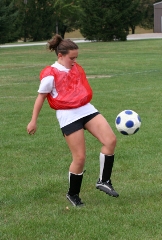Well "Balanced" Athletes
If you watched any soccer during the London Olympics like I did, you had to come away impressed with the pure athleticism elite soccer players possess. The speed, agility, strength, endurance, power, flexibility, and shooting and passing ability of the players on display at Wembley Stadium, Old Trafford, and St. James' Park were enough to entertain anyone who loves watching sports, even those new to the sport.
But soccer players are human just like the rest of us, so it isn't any wonder that they are also suffer a variety of injuries, including hamstring tears, sprained ankles, and low back strains. So, as it is with any sport and regardless of the level at which an athlete is playing, minimizing the risk of injury is critical for keeping a soccer player on the field.

Balance training helps
There are billions of cells in the human body called propriocepters. They work together to transmit a variety of sensory messages to the brain about things such as speed, direction, pressure, heat, cold, and vibration. Taken together, the information collected by propriocepters creates in an athlete an awareness about how his or her body feels in space when performing certain skills, whether it is in kicking a ball down the field or avoiding a slide tackle. In a very real sense, it is proprioception - the body's innate sense of movement in space - that makes an athlete "athletic."
One way to reduce an soccer player's risk of injury is to perform exercises designed to improve balance and proprioception, such as
- a single leg balance while tossing a ball back and forth
- single leg squats
- balancing on one leg on a foam pad
- walking on balance beam
- arm curls while in a lunge position; and
- walking "high kicks" with knee straight
The great part about balance training is that no heavy weights are necessary and can benefit any athlete at any age.
A three-year study of elite professional soccer players in Germany recently published in the American Journal of Sports Medicine1 showed that following a specific balance and proprioceptive training program helped reduce the incidence of common non-contact injuries, including hamstring strains, patellar tendonitis, and Achilles tendonitis.
Any athlete can improve balance
In the physical therapy world, part of the rehabilitation process often involves testing using simple side-to-side balance exercises to compare the injured side to the uninjured side. Very commonly, the balance of the uninjured ankle, knee, or hip is just as poor as the injured side. I often hear athletes say, "I just don't have good balance." This is nonsense. Having good balance is an essential part of athletic movement, regardless of the sport. It isn't reserved only for the martial arts and for gymnasts.
But here is the best part: every athlete can improve their athletic balance, not only improving their skills but reducing their risk of injury. Much of an athlete's skills, such as speed, power, and jumping ability, is dictated by genetics. Dedicated training and hard work can improve an athlete's skills some, but only take them so far.
But good balance is an athletic skill that can training can actually help. An athlete can train their body to achieve maximal awareness and focus on producing a particular task, whether its standing on one leg or jumping from square to square, and improving this particular aspect of athletic movement translates into the skills they need to be better players on the soccer field.
From ball-handling skills to landing softly on one leg as a way of reducing the risk of an ACL tear, balance training is something every young soccer player should include in their workout programs.
1. Kraemer R, Knobloch K. A Soccer-Specific Balance Training Program for Hamstring Muscle and Patellar and Achilles Tendon Injuries: An Intervention Study in Premier League Female Soccer. Am J Sports Med; 2009; 37(7).
Posted September 16, 2012








